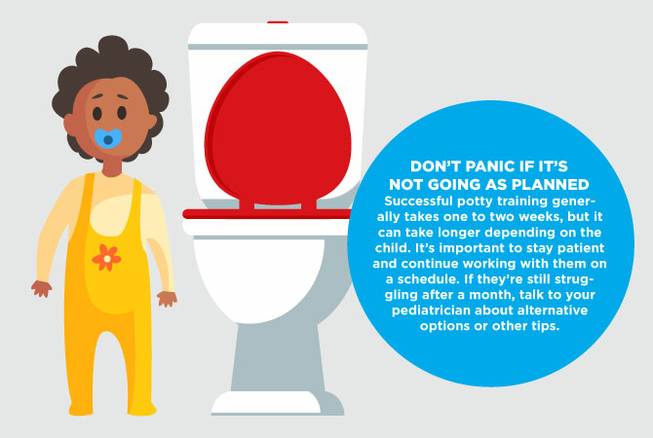
Monday, Feb. 20, 2017 | 2 a.m.
Potty training a toddler can be a complicated task, and there are many schools of thought on the topic, such as incentives and rewards or a series of learning aids. Choosing the right method for your child can seem daunting, but Waldo Feng, MD, pediatric urologist at Sunrise Children’s Hospital, argues that the process can be much simpler once parents know what physiological aspect to focus on.
“Many potty-training techniques focus on holding the urine, but in general, potty training should teach children to go regularly so they don’t have to hold it. ‘Holding it’ can cause many problems going forward, but teaching them to go before that point is healthier for the child and can make potty training easier for the parents,” Feng said.
Follow this guide when potty training your little one and soon enough, diapers will be a distant memory.
When is the right time to start?
The ideal time to start potty training is around 3 years. “At that age, a child’s bladder capacity is about five ounces and he or she will be producing about one ounce of urine every hour. They should learn to urinate when the bladder is about one-half to two-thirds full, which is about every two to three hours,” Feng said.
Some children may show interest in using the toilet sooner, or a little later, than 3 years old, and that’s fine, too. Some may be curious about the bathroom when they see what you or other family members do in there. If so, explain what’s happening, show them how it works, and answer their questions.
Other behavioral indicators that they may be ready include:
1. Is their diaper dry for two to three hours at a stretch?
2. Are they expressing what’s happening, either verbally or physically? This could mean saying that they’re going “pee-pee” or using body language or gestures to indicate what’s happening.
3. Are they pooping around the same time every day (after meals, in the morning, in the evening, etc.)?
4. Are they expressing impatience and/or unhappiness about a soiled diaper?
How to introduce potty training
Demonstrate the process for them. Speak to them in whatever language they use with you — whether it’s hand gestures, body language or verbal language — to explain what’s happening.
Then, put them on the toilet to get them comfortable with the idea that they can, and should, use it.
Schedule bathroom breaks and teach children to relax
Once they know what goes on in the bathroom, it’s time to get them on a schedule. Feng recommends taking them to the bathroom at 9 a.m., 12 p.m., 3 p.m. and 6 p.m.
“Put them on the toilet every day at these times and sit with them for 30 seconds. If they urinate, great. If not, it’s no big deal. The key is to do it on a schedule,” Feng said.
A regular schedule is integral when teaching children not to simply “hold it,” but to relax in order to urinate. When potty training, the focus should never be on holding it until they have to use the bathroom.
“Children often learn to ‘hold it’ because they get positive reinforcement from doing so. But this causes pressure releasing, because they’ve waited so long. Pressure releasing can not only delay the potty-training process, it can lead to bed wetting. It also can cause other health problems like incontinence, constipation, urinary tract infections and bladder dysfunction,” Feng said.
If children wait until they’re squirming around, crossing their legs, holding onto their genitals, or showing other signs of needing to use the bathroom immediately, they’ve waited too long. This is why putting them on a regular schedule is important — it teaches them to go before they reach this point.
Do rewards work?
Many children learn through rewards, encouraging words and positive reinforcement. This is no different while potty training, but it’s important that they’re rewarded for the right behavior. Instead of rewarding them for a dry diaper or going in the toilet, reward them for taking the bathroom break at all — whether or not they go.
You want to incentivize creating good habits, not necessarily producing good results.
Don’t just ask them if they need to use the bathroom
A common problem that parents encounter while potty training occurs when they ask their child if they have to use the bathroom. “Children almost always will answer, ‘No,’ ” Feng said. Don’t give them the option by asking — simply take them to the bathroom every 2-3 hours as scheduled and let them do their thing.
Don’t panic if it’s not going as planned
Successful potty training generally takes one to two weeks, but it can take longer depending on the child. It’s important to stay patient and continue working with them on a schedule.
If they’re still struggling after a month, talk to your pediatrician about alternative options or other tips.

Join the Discussion:
Check this out for a full explanation of our conversion to the LiveFyre commenting system and instructions on how to sign up for an account.
Full comments policy